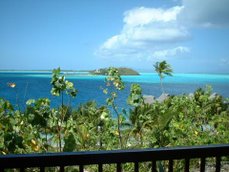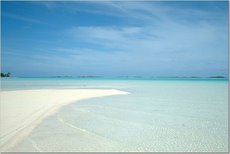Tahitipresse reported that "French Polynesia will hold a tsunami alert every Wednesday at noon with the 62 sirens already installed as the French state continues to install the rest of the total 144 sirens to be in place by the end of the year throughout the five archipelagos.
The French High Commissioner's Office tested some 12 sirens for the first time on Wednesday from Tahiti's north coast Commune of Arue to the southernmost Austral Islands and the northernmost Marquesas Islands and the Tuamotu Archipelago in between.
By coincidence, the test of French Polynesia's French state controlled and operated tsunami alert system occurred only a few days after a tsunami triggered by a powerful 8.1 magnitude earthquake claimed at least 32 lives, wiped out villages and left nearly 6,000 people homeless in the Solomon Islands.
The test occurred after three days of particularly unusual seismic activity in the southwestern region of the Pacific Ocean that produced nearly 40 smaller earthquakes, all of which had a magnitude of more than 5.5 on the open-ended Richter Scale.
One such quake had a magnitude of 6.3, occurring early Wednesday between New Caledonia's Loyalty Islands group and Vanuatu's Southern Tanna Island, according to the Denver-based U.S. Geological Survey Center. Like the powerful quake in the Solomon Islands on Monday, the less powerful quake occurred under the ocean.
The highly active seismic zone has sparked a continuing debate in the Pacific over the limits of tsunami warning systems and a need for better preparations.
In French Polynesia, the French state has been installing tsunami alert sirens on island after island and atoll after atoll. Each siren costs 1.5 million French Pacific francs (US$17,045/€12,570). So by the time all 144 are installed by the end of the year, the French state will have invested 216 million French Pacific francs (US$2.45 million/€1.8 million).
The sirens are set up to operate with the push of a button. The system does not need to rely on ordinary telephone service because it is hooked up directly to the first worldwide satellite network, Immarsat, explained Yves Hermann-Auclair. He works for the company Assystem, which is installing the sirens in French Polynesia.
Each siren also has its own independent electricity source, so the sirens would not be affected by power failures or blackouts, he said. The reaction time between pushing the button in Papeete and the wailing of the siren ranges from 45 seconds to two minutes, he said.
One push of the button can set off all the sirens in French Polynesia, or just those sirens in one archipelago, or even in one of the 48 communes throughout the French overseas community, previously known as a territory.
The French state's Geophysical Laboratory in the Pamatai suburb of Papeete watches seismic activity throughout the Pacific 24/7, so it would be the first to alert the High Commissioner's Office in Papeete of any approaching tsunami danger for French Polynesia.
There's also the Pacific Tsunami Warning Center in Hawaii, which notifies governments throughout the region of any tsunami activity.
Earthquake specialists say a tsunami early-warning system would have been of little use for the thousands of people in the Solomon Islands because they had only minutes to escape.
But in French Polynesia, which is relatively isolated in the eastern sector of the region, officials figure they have a lead time of between two to six hours, depending, of course, where and how deep in the ocean the earthquake occurred.
Depending on the origin of an earthquake triggering a tsunami, the Marquesas Islands could be much more vulnerable than the Tuamotu Archipelago, officials said. That is because none of the islands in the Marquesas group have protective coral reefs. That means there would be nothing to slow down a tsunami wave. That is the role the coral reefs play throughout the Tuamotus as well as the Gambier Islands, the Austral Islands and the Society Islands, which contain the most populated Windward Islands of Tahiti and Moorea and the tourism-oriented Leeward Islands.
Wednesday's first test of the tsunami early warning system made no noise in downtown Papeete because the capital has yet to install a siren. Each commune must ask the French state to install a siren, and Papeete's is due to be ready by the end of the year.
The tests will continue at noon on the first Wednesday of each month as new sirens are added. But in the Marquesas Islands, where the official time is 30 minutes behind Papeete and the rest of French Polynesia, the sirens will sound at 11:30 am."
Photo courtesty of Tahiti Tourisme.
The French High Commissioner's Office tested some 12 sirens for the first time on Wednesday from Tahiti's north coast Commune of Arue to the southernmost Austral Islands and the northernmost Marquesas Islands and the Tuamotu Archipelago in between.
By coincidence, the test of French Polynesia's French state controlled and operated tsunami alert system occurred only a few days after a tsunami triggered by a powerful 8.1 magnitude earthquake claimed at least 32 lives, wiped out villages and left nearly 6,000 people homeless in the Solomon Islands.
The test occurred after three days of particularly unusual seismic activity in the southwestern region of the Pacific Ocean that produced nearly 40 smaller earthquakes, all of which had a magnitude of more than 5.5 on the open-ended Richter Scale.
One such quake had a magnitude of 6.3, occurring early Wednesday between New Caledonia's Loyalty Islands group and Vanuatu's Southern Tanna Island, according to the Denver-based U.S. Geological Survey Center. Like the powerful quake in the Solomon Islands on Monday, the less powerful quake occurred under the ocean.
The highly active seismic zone has sparked a continuing debate in the Pacific over the limits of tsunami warning systems and a need for better preparations.
In French Polynesia, the French state has been installing tsunami alert sirens on island after island and atoll after atoll. Each siren costs 1.5 million French Pacific francs (US$17,045/€12,570). So by the time all 144 are installed by the end of the year, the French state will have invested 216 million French Pacific francs (US$2.45 million/€1.8 million).
The sirens are set up to operate with the push of a button. The system does not need to rely on ordinary telephone service because it is hooked up directly to the first worldwide satellite network, Immarsat, explained Yves Hermann-Auclair. He works for the company Assystem, which is installing the sirens in French Polynesia.
Each siren also has its own independent electricity source, so the sirens would not be affected by power failures or blackouts, he said. The reaction time between pushing the button in Papeete and the wailing of the siren ranges from 45 seconds to two minutes, he said.
One push of the button can set off all the sirens in French Polynesia, or just those sirens in one archipelago, or even in one of the 48 communes throughout the French overseas community, previously known as a territory.
The French state's Geophysical Laboratory in the Pamatai suburb of Papeete watches seismic activity throughout the Pacific 24/7, so it would be the first to alert the High Commissioner's Office in Papeete of any approaching tsunami danger for French Polynesia.
There's also the Pacific Tsunami Warning Center in Hawaii, which notifies governments throughout the region of any tsunami activity.
Earthquake specialists say a tsunami early-warning system would have been of little use for the thousands of people in the Solomon Islands because they had only minutes to escape.
But in French Polynesia, which is relatively isolated in the eastern sector of the region, officials figure they have a lead time of between two to six hours, depending, of course, where and how deep in the ocean the earthquake occurred.
Depending on the origin of an earthquake triggering a tsunami, the Marquesas Islands could be much more vulnerable than the Tuamotu Archipelago, officials said. That is because none of the islands in the Marquesas group have protective coral reefs. That means there would be nothing to slow down a tsunami wave. That is the role the coral reefs play throughout the Tuamotus as well as the Gambier Islands, the Austral Islands and the Society Islands, which contain the most populated Windward Islands of Tahiti and Moorea and the tourism-oriented Leeward Islands.
Wednesday's first test of the tsunami early warning system made no noise in downtown Papeete because the capital has yet to install a siren. Each commune must ask the French state to install a siren, and Papeete's is due to be ready by the end of the year.
The tests will continue at noon on the first Wednesday of each month as new sirens are added. But in the Marquesas Islands, where the official time is 30 minutes behind Papeete and the rest of French Polynesia, the sirens will sound at 11:30 am."
Photo courtesty of Tahiti Tourisme.

+flowers.jpg)

No comments:
Post a Comment